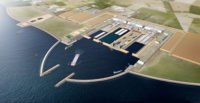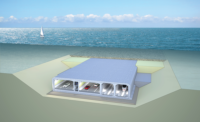Work is on course to begin later this year on the installation of the concrete components for the world's longest sunken tube, sited under the Fehmarnbelt strait between Denmark and Germany, now that crews have created the 11-mile tunnel's trench.
With dredging complete of the 260-ft-wide, 33-ft-deep channel, a separate French-led consortium has begun casting the first of the link's 89 concrete sections at Rodbyhavn, at the south end of Denmark's Lolland Island.
With a budget set by the Danish parliament in 2015 at roughly $8 billion, the project is due to replace a ferry with a four-bore tolled fixed link for vehicles and trains, in 2029.
Material ranging from soft clay to limestone blocks weighing up to 70 metric tons, presented "significant challenges" for the dredgers, says Pedro da Silva Jorgensen, technical deputy director of the state's project owner Femern A/S.
To dredge the 530 million cu ft of material for the trench, the Dutch consortium including Royal Boskalis Westminster NV and Van Oord NV deployed some 60 vessels of different types at peak.
 Map data: GeoBasis-DE/BKG, Go
Map data: GeoBasis-DE/BKG, Go
They included trailing suction hopper and backhoe dredgers, grab dredge pontoons and boulder clearance vessels, according to Bart Propper, the consortium's project director.
The team won the $640-million contract provisionally in May 2016, before the project's final go-ahead, and started work four years later.
At the same time, a consortium led by Vinci Grands Projets SAS secured three provisional contracts covering the rest of the work, altogether valued at $3.6 billion.
The focus of that work is at the large facility at Rodbyhavn in Lolland, where the contractor is casting the tunnel elements in six production lines. Five of the lines will produce 79 standard 73,500-metric-ton elements, each 712 ft long, 138 ft wide and 30 ft tall. The sixth line is dedicated to casting the 10 atypical elements containing the technical installations.
Across the strait on the German island of Fehmarn, a work harbor was completed last summer next to the Puttgarden ferry terminal.




